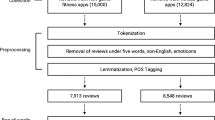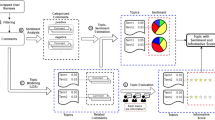Abstract
The concurrent think-aloud protocol (CTA) is an effective method for collecting abundant product comments related to user satisfaction during the execution of evaluation tasks. However, manual analysis of these audio comments is time-consuming and labor-intensive. This paper aims to propose an approach for automated comprehensive evaluation of user interface (UI) satisfaction. It takes advantage of text mining and sentiment analysis (SA) techniques instead of manual analysis in order to assess user comments collected by the CTA. Based on the results of the SA, the proposed approach makes use of the analytic hierarchy process (AHP) method to evaluate the overall satisfaction and support developers for UI design improvements. In order to enhance the objectivity of evaluation, a sentiment matrix originating from text mining and SA on user comments is used to replace the criteria and the relative weights of the AHP method which were previously defined by experts. A comparison between the questionnaire survey method and the proposed approach in the empirical study suggested that the latter can efficiently evaluate UI satisfaction with high accuracy and provide designers abundant and specific information directly related to defects in design. It is argued that the proposed approach could be used as an automated framework for handling any type of comments.



Similar content being viewed by others
Notes
https://www.w3.org/TR/CSS/
http://www.voicecloud.cn/
http://nlp.stanford.edu/software/segmenter.shtml
References
Frøkjær, E., Hertzum, M., Hornbæk, K.: Measuring usability: are effectiveness, efficiency, and satisfaction really correlated? In: CHI 00 Proceedings of the SIGCHI Conference on Human Factors in Computing Systems, pp. 345–352 (2000)
Calleros, J.M.G., Garca, J.G., Vanderdonckt, J.: Advance human machine interface automatic evaluation. Univers. Access Inf. Soc. 12(4), 387–401 (2013)
Whitefield, A., Wilson, F., Dowell, F.: A framework for human factors evaluation. Behav. Inf. Technol. 10(1), 65–79 (1991)
Davids, M.R., Chikte, U.M., Halperin, M.L.: Effect of improving the usability of an e-learning resource: a randomized trial. Adv. Physiol. Educ. 38(2), 155–60 (2014)
Pinelle, D., Wong, N., Stach, T.: Heuristic evaluation for games: usability principles for video game design. In: CHI 13 Proceedings of the SIGCHI Conference on Human Factors in Computing Systems, pp. 1453–1462 (2008)
Grigoreanu, V., Mohanna, M.: Informal cognitive walkthroughs (ICW): paring down and pairing up for an agile world. In: CHI 13 Proceedings of the SIGCHI Conference on Human Factors in Computing Systems, pp. 3093–3096 (2013)
Schoonewille, H.H., Heijstek, W., Chaudron, M.R.V.: A cognitive perspective on developer comprehension of software design documentation. In: SIGDOC 11 Proceedings of the 29th ACM International Conference on Design of Communication, PP. 211–218 (2011)
Nielsen, J.: Usability Engineering. Morgan Kaufmann Publishers Inc., San Francisco (1995)
Cooke, L.: Assessing concurrent think-aloud protocol as a usability test method: a technical communication approach. IEEE Trans. Prof. Commun. 53(3), 202–215 (2010)
Peute, L.W.P., Keizer, N.F.D., Jaspers, M.W.M.: The value of retrospective and concurrent think aloud in formative usability testing of a physician data query tool. J. Biomed. Inf. 55, 1–10 (2015)
Stefano, F., Borsci, S., Stamerra, G.: Web usability evaluation with screen reader users: implementation of the partial concurrent thinking aloud technique. Cognit. Process. 11(3), 263–272 (2010)
Ivory, M.Y., Hearst, M.A.: State of the art in automating usability evaluation of user interfaces. ACM Comput. Surv. 33(4), 470–516 (2001)
Lewis, C.H.: Using the thinking-aloud method in cognitive interface design. Research report RC-9265, IBM (1982)
Ericsson, K.A., Simon, H.A.: Protocol analysis: verbal reports as data. J. Market. Res. 23(3), 381–423 (1986)
Boren, T., Ramey, J.: Thinking aloud: reconciling theory and practice. IEEE Trans. Prof. Commun. 43(3), 261–278 (2000)
Hertzum, M., Hansen, K.D., Andersen, H.H.K.: Scrutinising usability evaluation: does thinking aloud affect behaviour and mental workload? Behav. Inf. Technol. 28(2), 165–181 (2009)
Olmsted-Hawala, E.L., Murphy, E.D., Hawala, S., Ashenfelter, K.T.: Think-aloud protocols: a comparison of three think-aloud protocols for use in testing data-dissemination web sites for usability. In: Proceedings of 28th International Conference on Human Factors in Computing Systems, PP. 2381–2390 (2010)
Anderson, E.W.: Customer satisfaction and word of mouth. J. Serv. Res. 1(1), 5–17 (1998)
Hu, N., Pavlou, P.A., Zhang, J.: Can online reviews reveal a product’s true quality? empirical findings and analytical modeling of online word-of-mouth communication. In: EC 06 Proceedings of the 7th ACM Conference on Electronic Commerce, PP. 324–330 (2006)
Hedegaard, S., Simonsen, J.G.: Extracting usability and user experience information from online user reviews. In: CHI’13 Proceedings of the SIGCHI Conference on Human Factors in Computing Systems, pp. 2089–2098 (2013)
Hu, M., Liu, B.: Mining and summarizing customer reviews. In: KDD 04 Proceedings of the Tenth ACM SIGKDD International Conference on Knowledge Discovery and Data Mining, pp. 168–177 (2004)
Wu, M., Wang, L., Li, M., Long, H.: An approach of product usability evaluation based on Web mining in feature fatigue analysis. Comput. Ind. Eng. 75(1), 230–238 (2014)
Kang, D., Park, Y.: Review-based measurement of customer satisfaction in mobile service: sentiment analysis and VIKOR approach. Expert Syst. Appl. 41(4), 1041–1050 (2014)
Arora, C., Sabetzadeh, M., Briand, L., Zimmer, F.: Automated checking of conformance to requirements templates using natural language processing. IEEE Trans. Softw. Eng. 41(10), 944–968 (2015)
Saaty, T.L.: Decision making with the analytic hierarchy process. Int. J. Serv. Sci. 1(1), 83–98 (2008)
Saaty, T.L.: Relative measurement and its generalization in decision making why pairwise comparisons are central in mathematics for the measurement of intangible factors the analytic hierarchy/network process, Revista de la Real Academia de Ciencias Exactas, Fsicas y Naturales. Serie A. Matemticas, Vol. 102, No. 2, September 2008, pp. 251–318 (2008)
Matsuda, M., Uesugi, Y., Nonaka, T., Hase, T.: Design method of UI of AV remote controller based on AHP. In: Proceedings of 26th IEEE International Conference on Consumer Electronics, pp. 1–2 (2008)
Delice, E.K., Güngör, Z.: The usability analysis with heuristic evaluation and analytic hierarchy process. Int. J. Ind. Ergon. 39(6), 934–939 (2009)
Albayrak, E., Erensal, Y.C.: Using analytic hierarchy process (AHP) to improve human performance: an application of multiple criteria decision making problem. J. Intell. Manuf. 15(4), 491–503 (2004)
Heim, S.: The Resonant Interface: HCI Foundations for Interaction Design. Addison-Wesley Longman Publishing Co., Inc., Boston (2007)
MA, Y.H., Wang, Y.C., SU, G.Y., Zhang, Y.M.: A novel Chinese text subject extraction method based on character co-occurrence. J. Comput. Res. Dev. 40(6), 874–878 (2003)
GE, B., Li, F., Guo, S., Tang, D.: Word s semantic similarity computation method based on Hownet. Appl. Res. Comput. 27(9), 3329–3333 (2010)
Freeman, B.: Triggered think-aloud protocol: using eye tracking to improve usability test moderation, In: CHI 11 Proceedings of the SIGCHI Conference on Human Factors in Computing Systems, pp. 1171–1174 (2011)
Vanderdonckt, J., Beirekdar, A.: Automated web evaluation by guideline review. J. Web Eng. Arch. 4(2), 102–117 (2005)
Acknowledgements
We would like to thank the anonymous interviewees and reviewers for their detailed and insightful comments. This research work has been partially supported by the Supporting Programs of Science and Technology Department of SiChuan Province of China Grants, Nos. 2013GZX0138, 2014GZ0063.
Author information
Authors and Affiliations
Corresponding author
Rights and permissions
About this article
Cite this article
Chen, W., Lin, T., Chen, L. et al. Automated comprehensive evaluation approach for user interface satisfaction based on concurrent think-aloud method. Univ Access Inf Soc 17, 635–647 (2018). https://doi.org/10.1007/s10209-018-0610-z
Published:
Issue Date:
DOI: https://doi.org/10.1007/s10209-018-0610-z




